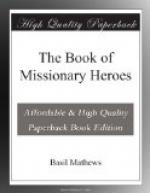Every use of saw and hammer and chisel, every
“trick of the tool’s true trade,”
all the training in the shipbuilding yards and engineering shops at Edinburgh and in Germany helped Mackay to invent some new, daring and ingenious way out of every fresh difficulty.
The Wreck of the “Daisy"
Now at last the Daisy was on the water again; and Mackay and his bearers went aboard[53] and hoisting sail from Kagei ran northward. Before they had gone far black storm clouds swept across the sky. Night fell. Lightning blazed unceasingly and flung up into silhouette the wild outlines of the mountains to the east. The roar of the thunder echoed above the wail of the wind and the threshing of the waves.
All through the dark, Mackay and those of his men who could handle an oar rowed unceasingly. Again and again he threw out his twenty-fathom line, but in vain. He made out a dim line of precipitous cliffs, yet the water seemed fathomless—the only map in existence was a rough one that Stanley had made. At last the lead touched bottom at fourteen fathoms. In the dim light of dawn they rowed and sailed toward a shady beach before the cliffs, and anchored in three and a half fathoms of water.
The storm passed; but the waves from the open sea came roaring in and broke over the Daisy. The bowsprit dipped under the anchor chain, and the whole bulwark on the weatherside was carried away. The next sea swept into the open and now sinking boat. By frantic efforts they heaved up the anchor and the next wave swung the Daisy with a crash onto the beach, where the waves pounded her to a complete wreck, wrenching the planks from the keel. But Mackay and his men managed to rescue her cargo before she went to pieces.
They were wrecked on a shore where Stanley, the great explorer, had years before had a hairbreadth escape from massacre at the hands of the wild savages. But Stanley, living up to the practice he had learned from Livingstone, had turned enemies into friends, and now the natives made no attack on the shipwrecked Mackay.
For eight weeks Mackay laboured there, hard on the edge of the lake, living on the beach in a tent made of spars and sails. With hammer and chisel and saw he worked unsparingly at his task. He cut the middle eight feet from the boat, and bringing her stern and stem together patched the broken ends with wood from the middle part. After two months’ work the now dumpier Daisy took the water again, and carried Mackay and his men safely up the long shores of Victoria Nyanza to the goal of all his travelling, the capital of M’tesa, King of Uganda.
The rolling tattoo of goat-skin drums filled the royal reception-hall of King M’tesa, as the great tyrant entered with his chiefs. M’tesa, his dark, cruel heavy face in vivid contrast with his spotless white robe, sat heavily down on his stool of State, while brazen trumpets sent to him from England blared as Mackay entered. The chiefs squatted on low stools and on the rush-strewn mud-floor before the King. At his side stood his Prime Minister, the Katikiro, a smaller man than the King, but swifter and more far-sighted. The Katikiro was dressed in a snowy-white Arab gown covered by a black mantle trimmed with gold. In his hard, guilty face treacherous cunning and masterful cruelty were blended.




